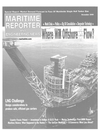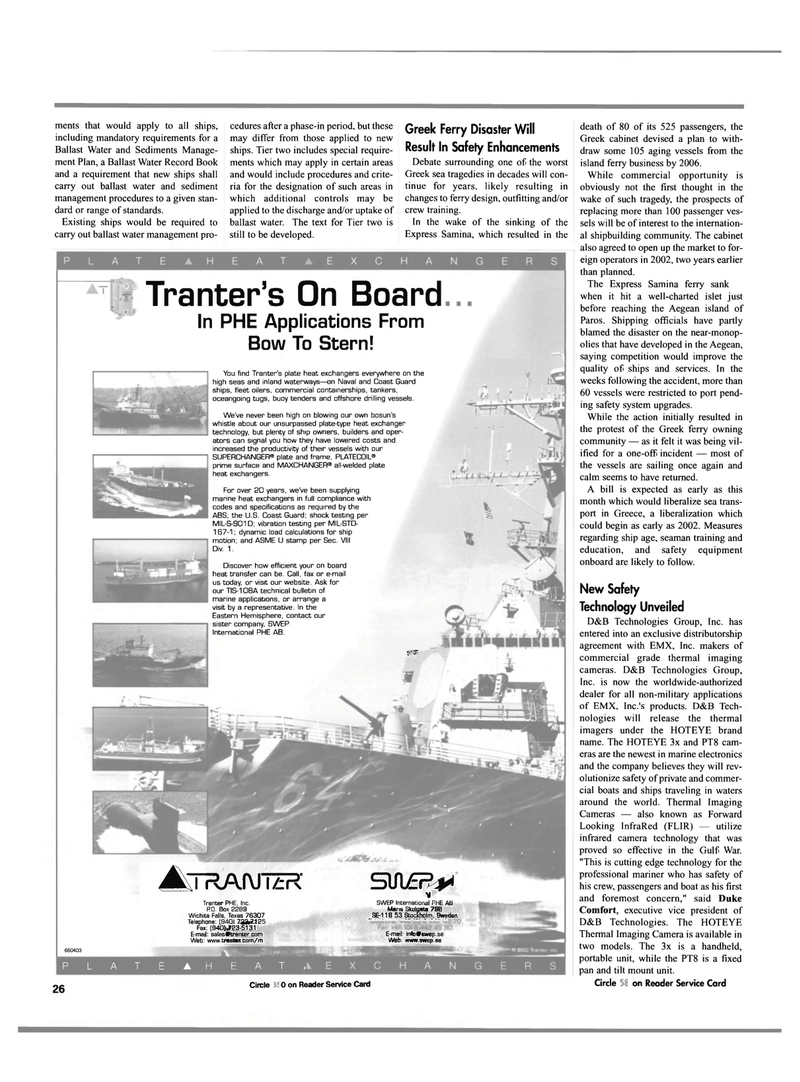
Page 28: of Maritime Reporter Magazine (November 2000)
Read this page in Pdf, Flash or Html5 edition of November 2000 Maritime Reporter Magazine
ments that would apply to all ships, including mandatory requirements for a
Ballast Water and Sediments Manage- ment Plan, a Ballast Water Record Book and a requirement that new ships shall carry out ballast water and sediment management procedures to a given stan- dard or range of standards.
Existing ships would be required to carry out ballast water management pro- cedures after a phase-in period, but these may differ from those applied to new ships. Tier two includes special require- ments which may apply in certain areas and would include procedures and crite- ria for the designation of such areas in which additional controls may be applied to the discharge and/or uptake of ballast water. The text for Tier two is still to be developed.
Greek Ferry Disaster Will
Result In Safety Enhancements
Debate surrounding one of the worst
Greek sea tragedies in decades will con- tinue for years, likely resulting in changes to ferry design, outfitting and/or crew training.
In the wake of the sinking of the
Express Samina, which resulted in the 26 Circle 280 on Reader Service Card death of 80 of its 525 passengers, the
Greek cabinet devised a plan to with- draw some 105 aging vessels from the island ferry business by 2006.
While commercial opportunity is obviously not the first thought in the wake of such tragedy, the prospects of replacing more than 100 passenger ves- sels will be of interest to the internation- al shipbuilding community. The cabinet also agreed to open up the market to for- eign operators in 2002, two years earlier than planned.
The Express Samina ferry sank when it hit a well-charted islet just before reaching the Aegean island of
Paros. Shipping officials have partly blamed the disaster on the near-monop- olies that have developed in the Aegean, saying competition would improve the quality of ships and services. In the weeks following the accident, more than 60 vessels were restricted to port pend- ing safety system upgrades.
While the action initially resulted in the protest of the Greek ferry owning community — as it felt it was being vil- ified for a one-off incident — most of the vessels are sailing once again and calm seems to have returned.
A bill is expected as early as this month which would liberalize sea trans- port in Greece, a liberalization which could begin as early as 2002. Measures regarding ship age, seaman training and education, and safety equipment onboard are likely to follow.
New Safety
Technology Unveiled
D&B Technologies Group, Inc. has entered into an exclusive distributorship agreement with EMX, Inc. makers of commercial grade thermal imaging cameras. D&B Technologies Group,
Inc. is now the worldwide-authorized dealer for all non-military applications of EMX, Inc.'s products. D&B Tech- nologies will release the thermal imagers under the HOTEYE brand name. The HOTEYE 3x and PT8 cam- eras are the newest in marine electronics and the company believes they will rev- olutionize safety of private and commer- cial boats and ships traveling in waters around the world. Thermal Imaging
Cameras — also known as Forward
Looking InfraRed (FLIR) — utilize infrared camera technology that was proved so effective in the Gulf War. "This is cutting edge technology for the professional mariner who has safety of his crew, passengers and boat as his first and foremost concern," said Duke
Comfort, executive vice president of
D&B Technologies. The HOTEYE
Thermal Imaging Camera is available in two models. The 3x is a handheld, portable unit, while the PT8 is a fixed pan and tilt mount unit.
Circle 362 on Reader Service Card
Tranter's On Board
In PHE Applications From
Bow To Stern! ^TRANTER
Tranter PHE, Inc.
R0. Box 2289
Wichita Falls, Texas 76307
Telephone: [94017^7,125
Fax: [940) 723-5131
E-mail: [email protected]
Web: www.tranter.com/rn 650403
P L A T I E A H E A T i
You find Tranter's plate heat exchangers everywhere on the high seas and inland waterways—on Naval and Coast Guard ships, fleet oilers, commercial containerships, tankers, oceangoing tugs, buoy tenders and offshore drilling vessels.
We've never been high on blowing our own bosun's whistle about our unsurpassed plate-type heat exchanger technology, but plenty of ship owners, builders and oper- ators can signal you how they have lowered costs and increased the productivity of their vessels with our
SUPERCHANGER® plate and frame, PLATECOIL® prime surface and MAXCHANGER® all-welded plate heat exchangers.
For over 20 years, we've been supplying marine heat exchangers in full compliance with codes and specifications as required by the
ABS; the U.S. Coast Guard; shock testing per
MIL-S-901D; vibration testing per MIL-STD- 1B7-1; dynamic load calculations for ship motion; and ASME U stamp per Sec. VIII
Div. 1.
Discover how efficient your on board heat transfer can be. Call, fax or e-mail us today, or visit our website. Ask for our TIS-108A technical bulletin of marine applications, or arrange a visit by a representative. In the
Eastern Hemisphere, contact our sister company, SWEP
International PHE AB. mm
SUl£Rr! v
SWEP International PHE AB
Maria Skolgata 79B
SE-118 53 Stockholm. Sweden
E-mail: [email protected]
Web: www.swep.se

 27
27

 29
29
